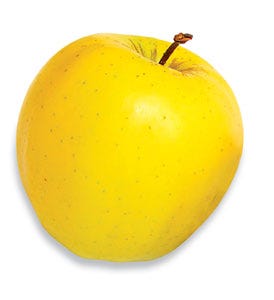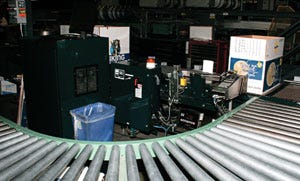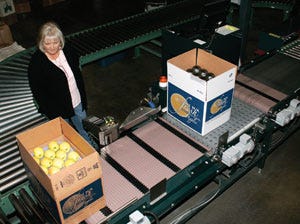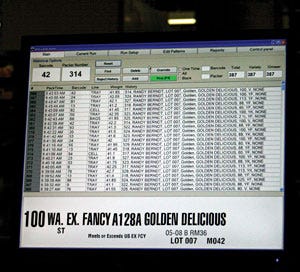New case coder and system software empowers apple grower
January 30, 2014
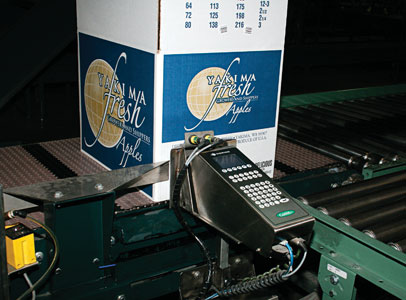
|
Strand Apples Inc., a Cowiche, WA, fruit and vegetable grower, takes great pride in its many varieties of apples, such as Red Delicious, Golden, Delicious, Gala, Fuji, Jonagold, Rome, Braeburn, Cameo, Granny Smith and two winter Pears (D'Anjou and Bosc).
Recently, Strand upgraded its sole apple case-packing line to deliver a healthy bushel of benefits, such as increased tracking capabilities, less maintenance and less labor. Strand packs the different types of apples in assorted case quantities, case sizes and case configurations. Due to the fact that apples come in different sizes, the cases may hold slightly different quantities when packed.
“Currently we work with about 20 different case configurations, but that can change when the market changes,” states Strand's co-general manager Gail Brown. “ Over the years, we have packed in many different case configurations—here are some standards—but to stay competitive in the market you have to be willing to change.”
|
New ink-jet coder applies |
For Sims Mfg., it's business as usual to design a case-packing line for fruits like apples that requires the ultimate in ease of use as well as an upgrade in controls, coding equipment and machine management. In 2008, Strand consulted Sims about installing new case-coding equipment for its apple-packing line which was equipped with a Sims automatic random case sealer.
“We have worked with Sims for so long that no one here remembers how we originally found them,” admits Brown. “We had outdated coding equipment that was limited in its capabilities and wanted less downtime to maintain and repair equipment and get a broader range of capabilities.”
So Sims selected a Model C6000 color ink-jet printer from Domino Amjet, which can generate bar codes, text and alphanumeric characters up to 2.7 in. high on one side of the shipping cases. The case coder was integrated with custom software controls combined with a Sims checkweigher.
“Earlier, we didn't have an automated scale in place,” Brown says. “We also wanted to scan as well as print bar-code labels, which would be very helpful in our hand-packing facility. This scanning and tracking ability is helping us track individual [case] packer totals more accurately.”
Software driving the coder, as well as the rest of the line, was created by systems integrator, Concept Systems, which created the specialized label-printing software for the line and provided human/machine interface software for the project.
|
After they’re weighed and scanned, the cases of apples convey past the ink-jet coder before they’re sealed and palletized. |
Team effort
“Meeting Strand's needs required a team effort,” says Darin Au, who is responsible for marketing and sales at Sims. Sims also built the weigh-scale mechanisms in-house and teamed the coder and checkweigher with a live-roller conveyor from Roach Conveyors.
The weighing/coding system measures 10.5 ft long. The arrangement includes a weigh scale section, a pacing belt that smoothly indexes the cases of apples as needed and an accelerating conveyor to space the cases to be weighed and coded. Sims also built a case turner using an Intralox ARB conveyor belt to transition the cases over to the coder. An integral reject sweeparm is provided at that point for cases that either don't get a bar code for some reason or are over- or underweight.
The system software runs on a PC and connects with Strand's host computer to input case counts and packing personnell identification.
Concept Systems' human-interface screens enable operators to easily make changes to case copy, the bar codes and other items printed on the sides of the apple cases.
“Software writing isn't our area of expertise, so we searched for a system integrator with a track record of developing human interfaces and ink-jet control applications,” Au remembers. “Concept Systems came highly recommended as very capable and an on-time developer.”
Adding to Strand's challenges lies in it being one of a handful of producer companies that pays packers by the case, meaning that it pays its apple-packing personnel for each case of fruit they pack as opposed to paying them an hourly wage.
Different apple varieties and case styles also have different pay scales. Subsequently, two different bar codes might be placed on each case: One code identifies an individual packer; and the other identifies the printed information applied to the case.
The C6000 can collect and/or print more than 50 variables per case. An operator is responsible for programming the variables while the coding software makes the operator's task easy, intuitive and accurate.
“We can now capture each packers' productivity [data] for a given time period and transfer it to our payroll system,” Brown adds. “The system is able to transfer this information by packer, case type (configuration) and quantity. We pay our packers on an individual packed case basis, so this has cut eight hours of time in payroll processing per week.”
And with so many case styles and variables, Strand needed a flexible system that could accommodate the many case types on-the-fly. “This system handles that with ease,” affirms Brown.
Au says that strand wanted a coder that was easy to use without extensive operator training or computer system maintenance. “We gave them an HMI interface and software that could show the exact markings being applied to the case and incorporate universal-language and visual icons.”
Software creation
To ensure that the functionality of the software met Strand's needs, as well as Sims', Concept Systems engineer Clay Horste developed a Functional Design Document (FDD), basically a contract between the system integrator and its customer that defines each function of a new system in clearly written language. The document lists every button and every page in a screen and report, as well as exactly how the software will react to user inputs.
Au explains, “This was the critical step in defining a system of this level of complexity.” The software is configurable to essentially an infinite number of custom configurations, Au relates, not including font sizes and field-location variables.
Careful planning, powerful processing tools like Visual Basic and SQL Server 2005 and precise execution were key. The flexible but powerful SQL database operator interface to the coder allows for data export should Strand need it. And, it can offer better compatibility with future Windows operating systems.
|
The apples are cleaned, coated, sorted, graded and sized before being packed into trays, which are layered in multiples into the shipping cases. |
Less-is-more approach
Once the FDD was defined and approved, Concept Systems mapped out software architecture to meet the requirements detailed in the FDD. The SQL offers great access to Windows' functionality to fulfill Strand's desire for a program that has a Windows look and feel. Simple viewing selections onscreen are easy to implement and have few hidden features. Concept Systems' Horste produced a software tool that could translate operator knowledge of apple varieties, grades, sizes, package types, lids, storage, weights, state lot codes and more.
The software transitioned into Strand's application without a hitch. “Most high-resolution printers we encountered weren't capable of receiving and processing a large unique bitmap every 700 milliseconds,” says Au. “Domino was able to work with Concept Systems to manage that outcome. Domino is one of the only companies that was willing to accept bitmapped information at the rates we needed.”
Variables are kept visible and available to a pattern onscreen at all times, in order to facilitate managing layouts and organizing data. And every piece of data printed on each case of apples can be saved and made available for reporting.
The software is easy to maintain using fewer operators, and requires no computer specialist involvement. Concept Systems also built in the ability to edit records for apple case production so that at the end of a shift, Strand can delete a production record if it desires, should a case of apples become damaged.
|
Strand’s new system software records |
The bigger picture
Brown points out that on any one day, Strand might pack as many as 36 apples per case to as many as 216 per case. The most common range is 88 to 113 apples per case. So Concept Systems designed a way for the equipment operators to see how the bar codes are set up before the run and before the codes are printed. The HMI screen presents operators with a matrix of bar codes to choose and a preview of the bar-code image, as well alphanumerics of what is encoded in the bar code symbology. Operators can use this feature to quickly monitor and modify system setup for the types of fruit are being packed.
The printer generates alphanumeric characters on one side of each shipping case that can include information such as apple-growing origin, date, lot number, the time the apples were packed, type of apple, grade of the apple and more. The bar coded data includes the same information and content details inside each case.
For some customers, a bar code is included on each case along with mandatory copy, such as “Grown in Washington.” Brown says that this allows Strand to know where each case has been shipped by lot number or pack date and to what customer, in what city and, in the event of a recall, if any of the selected recall cases are still waiting to be shipped.
Strand uses about 10 different bar code symbologies, but the system can generate as many as 200.
Scanning, weighing, coding
After the apples are cleaned, coated, sorted, graded and sized, they are delivered to the packing station in a bin. An operator/packer sorts the apples (the bin may contain two different grades or sizes of apples) and loads them into a tray, which is then placed into a half-slotted container (HSC) with an open lid. The HSCs and other case styles are erected by hand. The cases can hold four or five trays of apples, depending on their size. The operator then places the filled case onto a chain conveyor that transports it downstream to be scanned, checkweighed and coded.
Cases index to a Sick bar-code scanner, which identifies the two bar codes placed on the case by the packer/operator. Next, the bar codes are scanned into the ink-jet system, the codes are read and the case is then weighed. After weighing, the software system selects one of four bitmaps to send to the ink-jet coding equipment: One if the bar code wasn't scanned; one for an overweight case; one for an underweight case; or an assigned bitmap if the case passes those three exceptions.
The actual case weight is compared to a minimum and maximum weight assigned to the bar code that determines the print information. Sims equipped the checkweigher with four Cardinal loadcells and one Cardinal Model 205 weighment indicator. With scanning and weighing complete, the cases reach the ink-jet printer and are printed on one side.
A clear picture
Print resolution is also an issue, Au points out. “The new high-resolution ink-jet coder has several advantages,” he says. “The older dot-matrix printer's antiquated electronics had outlived our ability to service them with old PC technology. The new C6000 has a high-resolution printhead connected to the operator interface via 10baseT Ethernet communications. This allows Strand to code cases with information such as apple-treatment information, packed-by information and distributed-by information.” Product traceability is also becoming an industry must in the event of a recall, so the ability to produce Code 128 bar codes on the cases positions Strand to easily meet those requirements.
The software records the case data such as the apple variety, grade, size, package type, lid and storage details, which is all displayed onscreen, and also records the operator's number who filled the case. Strand can then export all of the information to a server to expedite payroll services with increased accuracy.
A pad is then inserted on top of the shipment and the case is tape-sealed on an existing Sims T-660 random case sealer after being turned by the case turner. This is done so that when the cases are palletized (which is performed manually, with five to seven cases per layer), each case end faces out, displaying the printed information and codes.
Speeds meet the need
Brown happily reports that the coder keeps pace with the packing line, which is also critical. The apples are usually packed at speeds of at least 28 cases/min, though the coding system can run about 42 cases/min.
On average, she points out, Strand packs about 4,000 cases in its daily 8- hour shift. “Line speed is important,” she emphasizes. “We have been able to improve operating speeds with less [equipment] breakdowns.”
Using Ethernet makes the system easier to maintain than other connection schemes, Au says. Concept Systems uses an Ethernet machine interconnect network for machine control, the most popular network on PCs, and a common element and operator-interface platform.
A new season approaches
Gearing up for a new apple season, Strand is excited about the software that runs the marking system because it can create advanced reports and access the reports over its company's intranet, and integrate this information with other plant data. It has a competitive advantage and allows personnel to devote more time to quality control.
About to begin working on the 2009 apple season, Strand is enjoying its packing line's smooth performance and competitive edge. The case coder generates codes that are as crisp as the apples themselves and the PC platform provides best-in-class, plug-in system components. Says Brown, “We now have the capabilities we wanted and needed, the accuracy and print quality we needed and can print more information. It has been well worth the investment.”
More information is available: |
Sims Mfg. Co. Inc., 509/453-7690. www.simsmfg.com |
Concept Systems Inc. 866/791-8140. www.conceptsystemsinc.com |
Domino Amjet, 800/486-7414. www.domino-na.com |
Cardinal Scale Mfg. Co., 417/673-4631. www.cardinalscale.com |
Intralox, 504/733-7543. www.intralox.com |
Roach Conveyors, 870/483-7631. www.roachconveyors.com |
Sick Inc., 800/325-7425. www.sickusa.com |
About the Author(s)
You May Also Like
